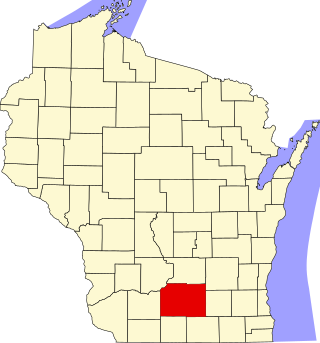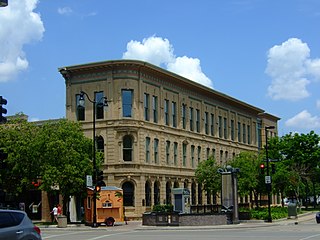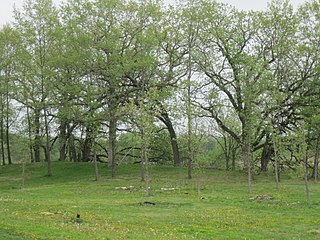
Aztalan State Park is a Wisconsin state park in the Town of Aztalan, Jefferson County. Established in 1952, it was designated a National Historic Landmark in 1964 and added to the National Register of Historic Places in 1966. The park covers 172 acres (70 ha) along the Crawfish River.

Cedarburg is a town in Ozaukee County, Wisconsin, United States, and is in the Milwaukee metropolitan area. The town was created in 1849 and at the time of the 2020 census had a population of 6,162.

The University of Wisconsin–Madison Arboretum is a teaching and research facility of the University of Wisconsin–Madison and the site of historic research in ecological restoration. In addition to its 1,260 acres (5 km2) in Madison, Wisconsin, the Arboretum also manages 520 acres (210 ha) of remnant forests and prairies throughout Wisconsin. It was designated a National Historic Landmark in 2021, in recognition for its role as a pioneer in the field of ecological restoration.

This is a list of the National Register of Historic Places listings in Dane County, Wisconsin. It aims to provide a comprehensive listing of buildings, sites, structures, districts, and objects in Dane County, Wisconsin listed on the National Register of Historic Places.

This is a list of the National Register of Historic Places listings in Crawford County, Wisconsin. It is intended to provide a comprehensive listing of entries in the National Register of Historic Places that are located in Crawford County, Wisconsin. The locations of National Register properties for which the latitude and longitude coordinates are included below may be seen in a map.

Cranberry Creek Archeological District, also known as Cranberry Creek Mound Group, is an ancient American Indian burial mound site from circa AD 100–800 near New Miner, Wisconsin, United States. It is three miles east of Necedah National Wildlife Refuge in Juneau County. It is part of the "effigy mound culture" of native peoples in Wisconsin, who practiced the "respectful burial of their dead".

The American Exchange Bank is an Italian Renaissance Revival-style business block built in 1871 in Madison, Wisconsin, and is one of the last such structures left on the Capitol Square. It was added to the National Register of Historic Places in 1980. The bank was also designated a landmark by the Madison Landmarks Commission in 1975.
Charles E. Marks (1875-1926) was a skilled carpenter who later became a general contractor in Madison, Wisconsin in the early twentieth century. Using mostly his personal designs, he built homes in the Prairie School design and American Craftsman style. He built many important buildings and homes in the Madison, Wisconsin area.

This is a list of the National Register of Historic Places listings in Madison, Wisconsin.

The Man Mound is a precontact earthwork of a humanoid figure located in Greenfield, Sauk County, Wisconsin, east of the city of Baraboo. Constructed during the Late Woodland period, the mound is the only surviving anthropomorphic effigy mound in North America. The mound depicts a humanoid figure with horns or a horned headdress and may have held religious or ceremonial significance to its builders. The mound was preserved as a county park in 1908, listed on the National Register of Historic Places in 1978 and designated a National Historic Landmark in 2016.

Vilas Circle Bear Effigy Mound and the Curtis Mounds are a group of Native American mounds in Madison, Wisconsin. The Bear Effigy Mound is in the public Bear Mound Park, while the Curtis Mounds are on a neighboring residential property. As its name indicates, the Bear Effigy Mound is in the shape of a bear, and is intact except for a section of the bear's leg. The Curtis Mounds were seven linear mounds running down the hill and several conical mounds. Now only parts of one or two linear mounds remain, on private property.

The Vilas Park Mound Group is a group of Native American mounds in Vilas Park in Madison, Wisconsin. The group includes a bird effigy, a linear mound, and six conical mounds. It originally included another bird effigy and two additional conical mounds, but development destroyed these mounds and damaged two of the existing ones.

The Elmside Park Mounds are a group of Native American mounds in Elmside Park in Madison, Wisconsin. The group includes two animal-shaped effigy mounds; while their shapes are inconclusive, they have been described as a lynx and a bear. The mounds were once part of the Oakridge Mound Group, which included three other mounds, but the others were destroyed by home construction. Mound Builder peoples built the mounds in the Late Woodland period, likely between 800 and 1100 A.D., to serve as burial and ceremonial sites. The mounds may be the only remnant of a Late Woodland community on the northeast shore of Lake Monona and are archaeologically significant in the study of Late Woodland civilizations.

The Mills Woods Mound, also known as the Hudson Park Mound, is a Native American mound in Hudson Park in Madison, Wisconsin. It is an animal-shaped effigy mound with a long tail, though the exact animal it represents is unclear. The mound was once part of the large Mills Woods Mound Group, which included roughly thirty mounds of various shapes, but construction destroyed every other mound in the group. The mound group was built during the Late Woodland period, roughly between 800 and 1100 A.D., by a Mound Builder group; the Mound Builders used mounds for burials and ceremonial purposes. The mound is one of less than 60 effigy mounds remaining in Dane County, which once had 289 of the mounds, and has potential archaeological significance for the study of Late Woodland civilizations.

The Pflaum-McWilliams Mound Group, also known as the Edna Taylor Conservancy Mound Group, is a group of Native American mounds in Madison, Wisconsin. Located in the Edna Taylor Conservancy in southeast Madison, the group includes an animal effigy mound and six linear mounds. The linear mounds are unusually long compared to other surviving mounds in the Madison area; the longest is 484 feet (148 m), and several are over 200 feet (61 m) in length. While a number of the linear mounds have been damaged, the group is generally well-preserved. The mounds were built during the Late Woodland period, most likely between 800 and 1100 A.D., and were thought to have been used for ceremonial purposes.

The Halvorson Mound Group is a group of Native American mounds in Yahara Heights County Park in Madison, Wisconsin. The group includes panther- and bear-shaped effigy mounds as well as an oval-shaped mound; a second panther mound and a linear mound were also once part of the site but were destroyed by farming. The remaining panther mound is a relatively large example at 228 feet (69 m) long. The mounds were built by Late Woodland people roughly between 800 and 1100 A.D. Charles E. Brown and Rev. F. A. Gilmore conducted the first survey of the mounds in 1911.

The Edgewood College Mound Group Archaeological District is a group of Native American mounds on the campus of Edgewood College in Madison, Wisconsin. The group includes two areas containing a total of 11-12 mounds; while there were once fifteen mounds at the site, the remainder have been destroyed by agriculture and construction. One of the mounds is a bird-shaped effigy, while the others are conical and linear; two other effigy mounds, both bear-shaped, were among those destroyed. The mounds were built by Late Woodland people between roughly 650 and 1200 A.D. White settlers likely first discovered the mounds in 1880; the establishment of Edgewood College in 1881 caused the mounds to be much more well-preserved than other groups in the area, some of which were completely destroyed.

Merrill Springs Mound Group II is a group of Native American mounds at 5030-5046 Lake Mendota Drive in Madison, Wisconsin. The group includes six to eight mounds and a nearby village site; it originally included up to 13-20 mounds, but many were destroyed by residential development in the area. It is one of four groups of mounds identified in an 1888 survey of the Merrill Springs resort area, which gives the group its name. The site includes two bear-shaped effigy mounds and an assortment of linear and conical mounds. The mounds were built by Late Woodland people between roughly 800 and 1100 A.D. The village site was also inhabited during the Late Woodland period, and projectile points and bones have been found there.

The Observatory Hill Mound Group is a group of Native American mounds on Observatory Hill on the campus of the University of Wisconsin–Madison. The group consists of two effigy mounds, one in the shape of a bird and the other in the shape of a double-tailed turtle or water spirit. A panther effigy and a linear mound were once part of the group as well, but these were destroyed in the twentieth century. The mounds were built between 650 and 1200 A.D. by the Late Woodland people, who were responsible for building effigy mounds throughout Wisconsin.

The Blackhawk Country Club Mound Group is a group of Native American mounds on the grounds of Blackhawk Country Club in Madison, Wisconsin. The group includes an effigy mound shaped like a flying goose, three bear-shaped effigy mounds, a panther-shaped effigy, and an assortment of linear and conical mounds. The mounds were built by Late Woodland people between 650 and 1200 A.D.; these people were part of Wisconsin's Effigy Mound Culture, which was responsible for building the many mounds that can be found throughout the state. Country club member L. J. Markwardt convinced the club to preserve the mounds and restore a damaged section of the goose in the 1970s.




















